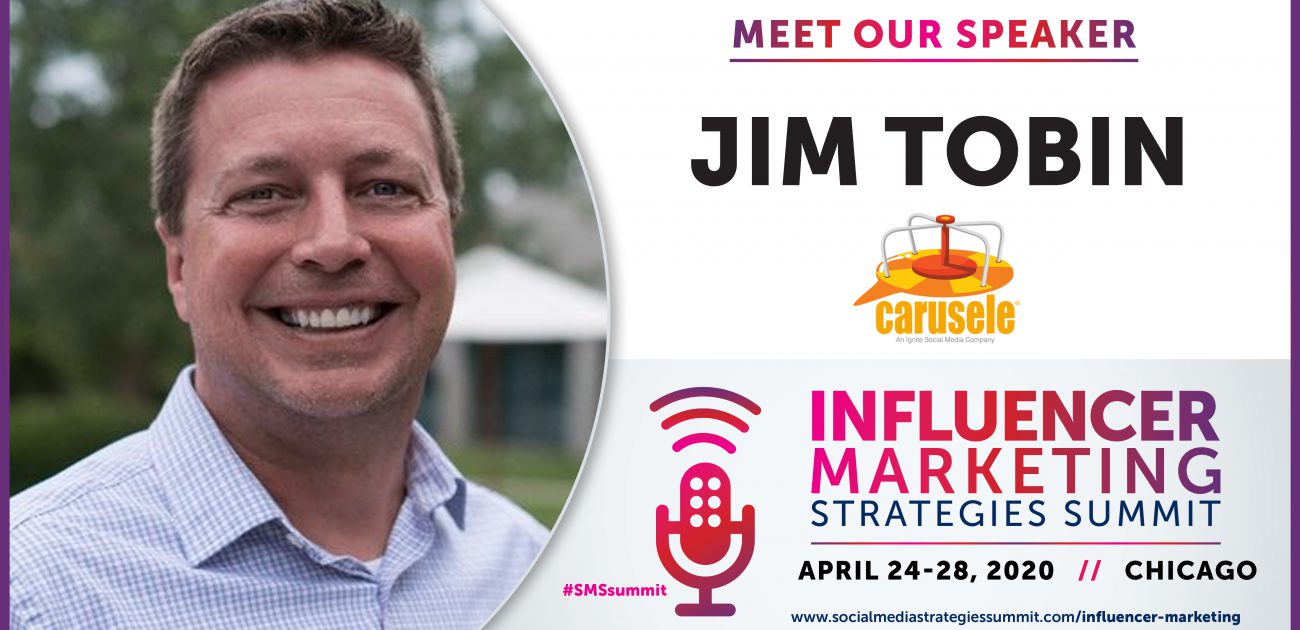The Influencer Summit team had the chance to sit down with Jim Tobin, president and founder of Carusele, the leading influencer marketing company for consumer brands and retailers. We asked him a few questions about what makes an influencer campaign work, how to create a meaningful influencer marketing strategy, and what he wishes influencers would stop doing.
How did you end up in marketing? What draws you to it, and specifically, Influencer marketing? Why do you love it?
Jim: I started in public relations and I think that background still impacts me today. To be really good at public relations, you have to be able to figure out how a given message can be conveyed, through a reporter, to reach the ultimate goal. That’s a tricky path to navigate. Now, with influencer marketing, there are similarities. I’m not here to impact the influencer at the end of the day, but to impact the influencer’s audience. You need a similar ability to understand what makes it work for everyone involved.
The other reason I think I get so much out of it is because I’ve been able to see, and measure, real sales results from many of the programs we work on. Back when I was doing traditional advertising on print, TV or radio, I almost never got to see these results. When you can actually see that people took buying actions because of something you played a small part in, that’s energizing to me.
What do you think separates a great Influencer campaign from a so-so one?
Jim: A great influencer campaign focuses on driving real business results. I was just reading about a massive investment in influencer that a brand made at the Super Bowl. It clearly cost millions and millions of dollars. I’m not privy to their particular measurement framework, but I’m really skeptical that it’s going to drive any real results for them. It seemed more designed to get written up in AdWeek than designed to get real consumers to purchase the actual product. That’s frustrating to me because I think it cheapens the industry. I saw it happen in social media around 2010 and we bounced back, but there are always people who feel like a big-budget excuses poor strategy. It just doesn’t.
Do you think Influencer Marketing has changed marketing strategy planning?
Jim: It has, but not enough. What I mean is that influencer marketing has begun to get brands to ask, ‘Who else can help us tell our story? That’s a good question to ask, but right now it’s often being asked in a silo with influencer campaigns running ‘off to the side’ of the regular program. Plus, ‘influencer marketing’ today is a sort of shorthand for social media influencers. But for a brand to answer that question more completely, they should think about their customers, trade media, employees, and much more. A great marketing strategy would think about all of these things during the planning process.
How do you see for Influencer Marketing impacting culture, and what ways do you think Influencers can help champion social causes?
Jim: A new Instagram account called “Influencers In the Wild” shot to 1.1M followers after only 100 posts by highlighting the sometimes ridiculous things we do “for the ‘gram.” A lot of the posts on this account are likely influencers doing paid work, but so many are doing things we all do. My kids like to somewhat jokingly say, “The phone eats first,” so they can get their food pics. And we’re all using tricks and editing apps that early adopters taught us.
Increasingly, influencers are brands. And more and more people (particularly younger people) expect brands to stand for something. That gives influencers a chance to stand for particular social causes. Doing this can deepen their connection with their followers.
And that connection to their followers is really what they sell.
What’s the one thing you wish Influencers would stop doing? Why?
Jim: This is by no means meant to apply to all influencers, but I do see some influencers playing the short game instead of thinking about their long-term potential. A survey we conducted a few years ago showed that most influencers plan to stay involved for as long as they are able. But then I see some doing two things in particular that are shortsighted.
Doing all sponsored content: Some influencers now post nothing but sponsored content. They no longer create the original content that got them a following (and influence) in the first place. As measurement increases in the space, brands will increasingly see that these accounts don’t drive real business results, and they will ultimately lose significantly.
Fake endorsements: We see the Starbucks lover (organically) suddenly paid to say they love Dunkin’. Or the influencer doing a great sponsored post in their news feed and then going in their Stories to badmouth that same brand. We don’t say anything, but we see that and make a note to never work with that influencer.
Nothing is more valuable than a brand, and that’s particularly true for an influencer’s brand. Avoiding shortsighted mistakes like these will pay dividends in the long term.
Thanks Jim! We’re excited to hear more and can’t wait to have you emcee and speak at our Influencer Marketing Strategies Summit this April in Chicago.









